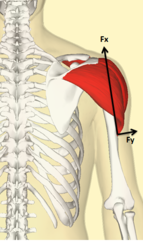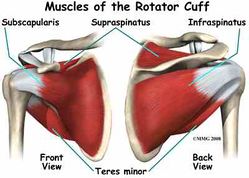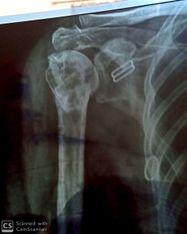Dynamic Stabilisers of the Shoulder Complex: Difference between revisions
No edit summary |
No edit summary |
||
| Line 72: | Line 72: | ||
[[Winged scapula|Scapular weaning]], [[Scapular Dyskinesia|scapular dyskinesia]] that happen due to imbalance of scapulothoracic muscles, for example, serratus anterior, lower trapezius weakness, upper trapezius overactivation. | [[Winged scapula|Scapular weaning]], [[Scapular Dyskinesia|scapular dyskinesia]] that happen due to imbalance of scapulothoracic muscles, for example, serratus anterior, lower trapezius weakness, upper trapezius overactivation. | ||
== Physical therapy intervention == | == Physical therapy intervention == | ||
The role of physical therapy concentrates on to restore normal [[Biomechanics of the Shoulder|biomechanical alignment]], the balance of force between muscles so the general treatment plane: | The role of physical therapy concentrates on to restore normal [[Biomechanics of the Shoulder|biomechanical alignment]], the balance of force between muscles so the general treatment plane: | ||
Revision as of 12:06, 12 April 2020
Original Editor - Khloud Shreif
Top Contributors - Khloud Shreif, Amanda Ager, Kim Jackson and Rishika BabburuIntroduction[edit | edit source]
The stability of the shoulder joint like any other joints in the body depends on the static and dynamic stabilizer, static stabilizers of shoulder are joint labrum and capsuloligements component. .Dynamic stabilizers we mean muscles for example (supraspinatus, infraspinatus, subscapularis, tee s minor) plus periscapular muscles[1], which are very important for homogeneous shoulder movement to avoid some of the shoulder problems for example: shoulder impingement. Dynamic stability of shoulder divided into; glenohumeral stability/local and scapulothoracic contribution stability/global.

Glenohumeral joint stability[edit | edit source]
Deltoid and Rotator cuff[edit | edit source]
Deltoid muscle[edit | edit source]
Deltoid has a significant role as a stabilizer and generally accepted as a prime mover for glenohumeral abduction along with supraspinatus.
From the figure that shows the line of action of deltoid with the arm at side, the parallel force component (fx)directed superior is larger of three other components so that, the majority of deltoid contraction causes humeral head translates superior and a small applied perpendicular force is directed to rotate the humerus. That we need an inferior pull force to offset the (fx) component of middle deltoid for active arm elevation as gravity force can't balance this force.[3]
Rotator cuff muscles[edit | edit source]
Rotator cuff not only abduct the shoulder it plays a role as a stabilizer muscles[4]
From figure 2 we can see all three muscles (teres minor, subscapularis, infraspinatus) in relation to their anatomical position and their muscle fiber direction from origin to insertion, tend to have a similar inferior line of pull[2] and with the summation of three forces of rotator cuff, they nearly offset superior translation of humeral head created by deltoid. The wide range of motion of the shoulder is allowed by the variety of rotational moments of the cuff muscles[5]. Teres minor, Infraspinatus as they are external rotators they contribute in abduction of arm by external rotation that participate clearing greater tubercle underneath the acromion.
Supraspinatus muscle[edit | edit source]
Regarding supraspinatus location more superior than the three other rotator cuff it has a line of pull superior that can't offset deltoid force.
Even though it still an effective stabilizer due to it's larger moment arm, it's capable to elevate glenohumeral joint near normal.[2]
From illustrated above we can consider deltoid and rotator cuff as one of a force couple of glenohumeral joint.
Imbalance of one or more of these muscles consider a contribution cause to shoulder problems (impingement, bursitis, instability )
Scapulothoracic joint stability[edit | edit source]
For full rang shoulder elevation and reaching activities we need a force couples act on scapulothoracic joint for full rhythmic movement
Serratus anterior muscle and Trapezius[edit | edit source]
Serratus anterior[6][edit | edit source]
Serratus anterior muscle as a primary protractor muscle of scapula, it's capable of producing scapular protraction, upward rotation, external rotation and posterior tilting of the scapula with progress arm elevation.
The strong action of serratus as a protractor needs an apposite force to control this movement. Serratus anterior and trapezius muscles work as a primary force couple to rotate scapula upward.
Trapezius muscle[7][edit | edit source]
Trapezius has a retraction effect on scapula to counter the protraction and lateral pull of serratus anterior.
Upper trapezius[edit | edit source]
Take in consideration it's insertion to the clavicle, it produces upward rotation of scapula indirect and contributes to first degrees of clavicle elevation and retraction.
Middle trapezius[edit | edit source]
Contributes to offset the strong action of serratus anterior as a protractor and also produces an external rotation of scapula but it has a downward moment arm on scapula larger than it's upward moment arm.
Lower trapezius[edit | edit source]
With serratus anterior, lower trapezius is a primary upward rotator of scapula, it creates an upward rotation moment arm when the axis reaches acromioclavicular joint.
Serratus anterior and trapezius muscles they act agnostic for scapular movement and as a synergistic with glenohumeral forces[edit | edit source]
Rhomboid muscle and Teres major[edit | edit source]
- The rhomboid downward rotation action on scapula help to offset the undesired upward rotatory torque of teres major
- Rhomboid acts eccentrically to control change position of scapula during arm elevation so it contributes to counter the lateral translation force of serratus anterior.
- It has another stabilization role for scapula during adduction or extension.
Clinical presentation[edit | edit source]
For smooth synchronous movement of shoulder girdle we need the force couples of glenohumeral and scapulothoracic to work in proper timing and adequate forces to offset each other.
For example; the deltoid (middle fiber) acts to stabilize the humeral head against the glenoid cavity with small participation to abduct the arm, there are(subscapularis, teres minor, infraspinatus) their forces balance the deltoid action and along with supraspinatus that participates mainly in arm abduction.
Deficit in these forces for example; insufficient activation of rotator cuff /deltoid over activation participate to narrowing coracoacormial space (figure 3) that compress tendons in this space ( rotator cuff tendinopathy /shoulder impingement)[9]
Scapular weaning, scapular dyskinesia that happen due to imbalance of scapulothoracic muscles, for example, serratus anterior, lower trapezius weakness, upper trapezius overactivation.
Physical therapy intervention[edit | edit source]
The role of physical therapy concentrates on to restore normal biomechanical alignment, the balance of force between muscles so the general treatment plane:
Strengthening for weak / inhibited muscles like serratus anterior, rotator cuff muscles, lower trapezius
Eccentric exercise for rotator cuff in case of rotator cuff tendinopathy to restore collagen alignment of tendon.
Muscles re-education to be activated in proper time is important to restore balance.
For more exercise this page below:
References[edit | edit source]
- ↑ Curl LA, Warren RF. Glenohumeral joint stability: selective cutting studies on the static capsular restraints. Clinical Orthopaedics and Related Research®. 1996 Sep 1;330:54-65.
- ↑ 2.0 2.1 2.2 Levangie PK, Norkin CC. Joint Structure and Function; A Comprehensive Analysis. 5th. Philadelphia: Fadavis Company. 2012.
- ↑ Levangie PK, Norkin CC. Joint Structure and Function; A Comprehensive Analysis. 5th. Philadelphia: Fadavis Company. 2012.
- ↑ Escamilla RF, Yamashiro K, Paulos L, Andrews JR. Shoulder muscle activity and function in common shoulder rehabilitation exercises. Sports medicine. 2009 Aug 1;39(8):663-85.
- ↑ Longo UG, Berton A, Papapietro N, Maffulli N, Denaro V. Biomechanics of the rotator cuff: European perspective. InRotator Cuff Tear 2012 (Vol. 57, pp. 10-17). Karger Publishers.
- ↑ Neumann DA, Camargo PR. Kinesiologic considerations for targeting activation of scapulothoracic muscles: part 1: serratus anterior. Brazilian journal of physical therapy. 2019 Feb 2.
- ↑ Camargo PR, Neumann DA. Kinesiologic considerations for targeting activation of scapulothoracic muscles–part 2: trapezius. Brazilian journal of physical therapy. 2019 Feb 3.
- ↑ Muscle and Motion. Force Couple , Scapular Force Couple. Available from: http://www.youtube.com/watch?v=YbbzQs7OBoY[last accessed 12/3/2020]
- ↑ <article> Joseph B. Myers, Ji-Hye Hwang, Maria R. Pasquale, J. Troy Blackburn and Scott M. Lephart. Rotator cuff coactivation ratios in participants with subacromial impingement syndrome. Journal of Science and Medicine in Sport, Volume 12, Issue 6, November 2009, Pages 603-608 </article>
- ↑ White Lion Athletics. Resistance Band Exercises: Best Exercises for Shoulder Rehab and Scapular Stabilzation. Available from: http://www.youtube.com/watch?v=Vez6-NTFkS8[last accessed 11/4/2020]








